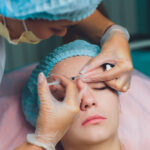Have you ever wondered how Botox evolved from Botulinum Toxin Type A to the number one non-surgical cosmetic treatment in the United States? Well, believe it or not, the story starts way back in the 1820s! A German Doctor named Justinus Kerner was the first to begin to understand the biological causes for food poisoning when he studied a batch of bad sausages that had made several dozen Germans gravely ill. Kerner’s experiments and studies helped the medical community better understand the neurological effects of botulism and he was also instrumental in more effective prevention and treatment of food poisoning.
Then, 70 years later in the 1890s further advances were made by Dr. Emile Pierre Van Ermengem of Belgium. Another outbreak of food poisoning led Dr. Van Ermengem to make a connection between botulism and a spore-forming bacterium he named Bacillus botulinus (it was later renamed Clostridium botulinum). A series of studies followed and seven strains of botulinum toxin were eventually identified (A through G); four of them (A, B, E and F) would be shown to cause illness in humans.
Another 50 years went by and the U.S. began researching biological weapons during World War 2. A plan was made to poison Japanese general with botulinum toxin in the form of tiny pills. This plan was abandoned and research in the 50s and 60s moved on to how botulinum toxin might be beneficial instead. Scientists found that injecting purified botulinum toxin type A into hyperactive muscles resulted in temporary relaxation. In the 60s researchers used botulinum toxin type A to treat crossed eyes in monkeys.
By the 70s and 80s, the opthalmologist who had conducted the research on the monkeys was given the go ahead by the FDA to try injecting humans. In the early 1980s, the eye doctor published a number of studies including a 1981 paper in the Transactions of the American Ophthalmological Society that asserted botulinum toxin “appears to be a safe and useful therapy for strabismus.” Further research revealed additional benefits including temporary relief from facial spasms, neck and shoulder spasms, and even vocal cord spasms. In 1988, drug manufacturer Allergan acquired the rights to distribute botulinum toxin type A (or Oculinum, as it was then known). In 1989 the FDA approved botulinum toxin type A for the treatment of both strabismus and blepharospasm (spasms of the eyelid muscle). At that time Allergan changed the drug’s name to the much more catchy (and easier to say) “Botox.”
In the 1990s, more research led to the discovery of more uses for Botox. It was helpful in treating excessive sweating, bladder spasms, writer’s cramp, and even cerebral palsy in children. Additionally, Botox has been found to help treat migraines. The big breakthrough came when a Doctor who was treating her patients who had blepharospasm with Botox, noticed that their frown lines were disappearing. In 1992, she and her dermatologist husband published a study in the Journal of Dermatologic Surgery and Oncology stating that though temporary, “treatment with C. botulinum-A exotoxin is a simple, safe procedure” for the treatment of brow wrinkles. Right away, dermatologists all over North America took note and began to use Botox to treat wrinkle and frown lines in their patients. By 1997, the use of Botox spiked so high that supply ran out, causing panic among its devotees and leading to a headline in The New York Times that announced “Drought Over, Botox Is Back” once a new batch received FDA approval.
By 1992, the FDA approved Botox for cosmetic use and it has been growing in popularity ever since then. Of course it is always good to make sure that you are receiving your Botox from a certified Medical Professional who has been educated and is well versed in cosmetic procedures. But isn’t it great to know that something that was discovered in a “bad” sausage hundreds of years ago is now safe and incredibly useful in treating so many different things?


